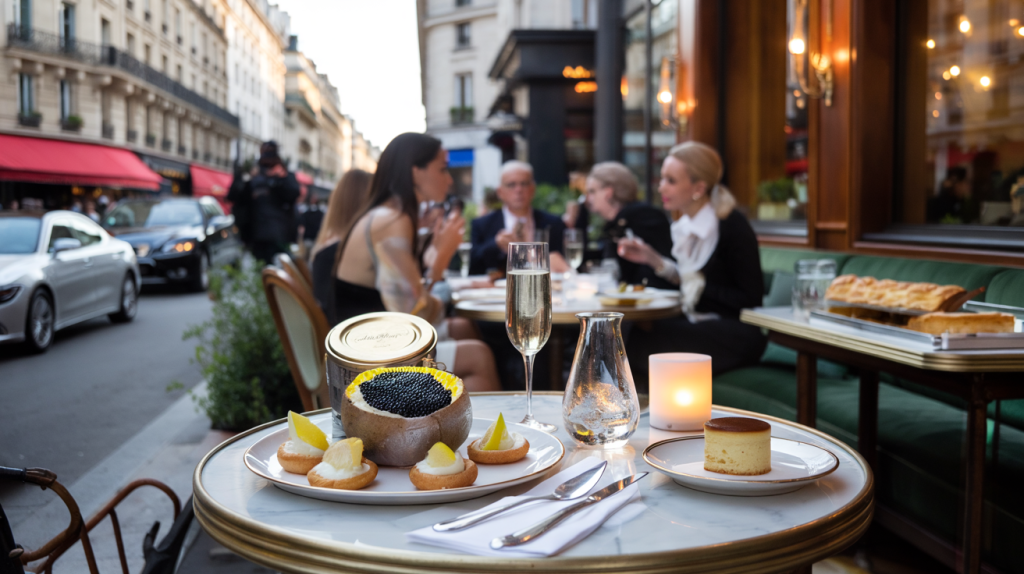Paris has a way of turning dinner into a scene. Certain dining rooms have become magnets for celebrities and fashion crews, the kind of places where a simple roast chicken suddenly feels like a headline. This guide goes straight to the point. Which cult restaurants draw stars, why they matter, and how a regular diner can still get in without stress.
The appeal is not just about fame watching. These rooms carry decades of lore, signature dishes that never leave the menu, and a specific Parisian rhythm. From historic brasseries on grand avenues to low lit addresses a few steps from couture houses, the city has curated a shortlist of spots that keep showing up in photos and stories. That is the context readers came for.
Iconic Paris restaurants celebrities actually visit
On Avenue Montaigne, L’Avenue sits within walking distance of flagship fashion boutiques. The dining room pairs sleek banquettes with a sidewalk terrace that functions like an informal runway. Paparazzi have photographed Kim Kardashian stepping in and out more than once, which helped cement its aura among visitors chasing that same energy.
Just off Place de la Madeleine, Caviar Kaspia has become a ritual for fashion week dinners. Its baked potato topped with caviar is a house emblem, served since its early years. The brand dates back to 1927, a detail documented by the company itself (source: Caviar Kaspia). During show days, editors and models often slide into its wood paneled booths after late presentations.
On the Champs Elysées, Fouquet’s anchors big Paris nights. The brasserie opened in 1899 and has hosted film world events tied to the César Awards, a line the Barrière group recounts in its own history page (source: Le Fouquet’s). Close by, Maxim’s has its own timeline. The Art Nouveau landmark started in 1893 and still signals Belle Époque glamour on Rue Royale, information listed on the brand archives and historical notes (source: Maxim’s).
Café de Flore appears slower by design. The Saint Germain institution has poured hot chocolate since 1887, a date the café communicates openly on its site and menus (source: Café de Flore). Artists made its reputation in the twentieth century. Today a few actors and musicians still swing by at off peak hours, often sliding upstairs for privacy.
What to expect once inside these rooms
There is a pattern. Service runs brisk but warm, tables sit close, and the soundtrack is conversations, not DJs. Menus are comfort first with a Paris twist. At L’Avenue, expect roast chicken, truffle pasta or a simple tartare. Caviar Kaspia keeps its caviar focus with blinis, smoked fish and that famous potato. Fouquet’s serves classics like sole meunière and a precise millefeuille. Café de Flore is all about croques, eggs and timeless desserts.
Celebrities do not create the experience, they orbit around it. Staff are trained to keep the room calm, phones stay low, and the whole point is to let the table carry the moment. That is the signal these places send every day.
How to land a table without the stress
Demand peaks during Paris Fashion Week and big events. Outside those windows, access gets easier, especially for lunch and late dinners. A short phone call often beats unanswered emails. Flexibility helps. So does a clear ask for the terrace or a corner inside.
Here is a quick playbook that actually works:
- Call the restaurant directly and ask for lunch on a weekday or a late second seating.
- Be open to the bar or counter if available, it can unlock last minute seats.
- Aim for the first or last hour of service, when turnover is higher.
- If the date is full, ask the host for the waitlist timing and reconfirm the same day.
- Dress smart casual and arrive on time, hosts remember low effort manners.
Service in France includes a gratuity in menu prices. Many locals still leave a little extra in cash when the experience clicks, often a few euros or roughly five to ten percent for special care. It is optional and discreet.
Price signals, tiny rituals, and timing that change everything
Classic dishes at these addresses rarely shock. The strategy is to focus on signature plates that never miss. At Caviar Kaspia, that means the caviar potato or salmon with blinis. At Café de Flore, the chocolat chaud and a simple croissant in the morning. At Fouquet’s, lean into the pâtisserie trolley.
Two micro moves tend to improve the night. First, choose tables that sit slightly off the main aisle. Second, keep photos to a minimum. Not because there is a strict policy, more because meals flow better when phones stay pocketed. Staff notices and the room breathes.
For calendars, note a few anchors. Womenswear ready to wear shows cluster in late February or early March and again in late September. Menswear weeks run in January and June. Couture shows unfold in January and July. These windows pull in media and talent, which naturally swells demand around places like Caviar Kaspia and L’Avenue. Off season travel definetly helps.
One last fact helps frame the obsession with history. Café de Flore dates to 1887, Fouquet’s to 1899, and Maxim’s to 1893, all dates cited by their own official materials. Longevity explains why these rooms feel both familiar and sharp. They have had time to edit what works and keep it in place.
